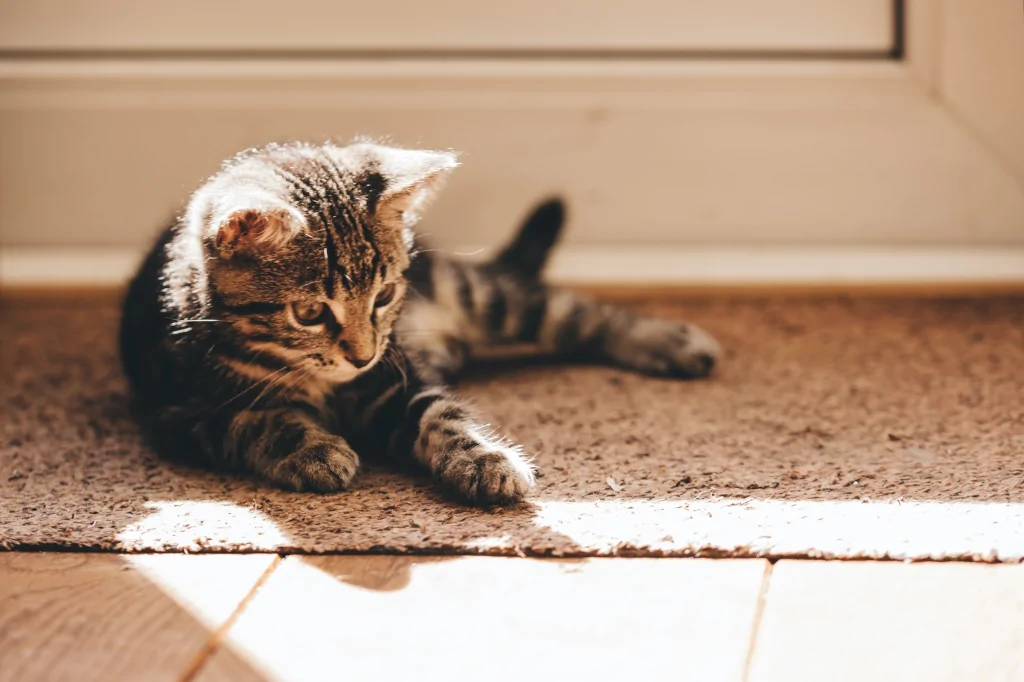Disclosure: We may earn a commission from helpful, relevant links in our content. No cost to you. See our privacy policy.
We get it. Finding your favorite rug or freshly washed laundry soiled by your feline friend isn’t exactly the highlight of your day.
The confusion, the frustration, and let’s not forget that stubborn stain! It’s enough to make anyone’s whiskers twitch in annoyance.
But remember, your cat isn’t plotting against your sanity. Inappropriate elimination is your cat’s unique, albeit inconvenient, way of saying, “Something’s not right here.”
As loving and concerned pet parents, it’s our job to decode these messages and address the underlying issues. So, let’s get our detective hats on and crack this case of ‘cat speak’ together, shall we?

Identifying the Cause: Stress, Medical Issues, or Behavioral?
First off, high paws for being here and taking the initiative to understand your cat better. It’s the first step to solving the problem.
Now, onto the business of identifying potential triggers for your cat’s sudden shift in bathroom habits.
While our previous blog post “Why Your Cat Ignoring Litter Box and How to Fix” covered some possible reasons, such as dissatisfaction with the litter box, its location, or the type of litter, we’ll venture into some other potential triggers here.
Firstly, let’s talk about stress. Just like us, our feline friends can be sensitive to changes in their environment. A new family member, a move to a new house, or even a new piece of furniture can cause stress, leading to inappropriate elimination.
Keep an eye out for any changes in your cat’s environment that coincide with their new bathroom habits.
Secondly, medical issues can also be the culprit. Conditions like urinary tract infections, kidney disease, or diabetes can lead to increased urination. If your cat suddenly starts eliminating outside the box, it’s a good idea to rule out these medical issues with a quick trip to the vet.
Lastly, behavioral issues could be at play. Some cats may develop a substrate preference, meaning they prefer to eliminate on certain materials like carpet or clothing. Others might develop a location preference, deciding that the corner of the living room is much more appealing than their litter box.
So, as you see, the reasons behind this behavior can be quite varied. The key is to approach this issue with patience, observation, and a bit of feline intuition.
You know your cat best, and with a little detective work, you’re well on your way to restoring harmony in your household.
Steps to Correct Inappropriate Elimination
Alright, now that we’ve talked about possible causes, let’s roll up our sleeves and dive into the solutions. After all, what we want is to help our furry friends feel comfortable again, and restore our homes to their pre-soiled glory, right?
Monitor for Stress Indicators
Remember how we mentioned that environmental changes could trigger stress in cats? Keep a watchful eye on your cat’s behavior during these changes.
Is there a new pet in the house? Have you recently moved? Even rearranging furniture can be a big deal for them. Try to introduce changes gradually, if possible, to help your cat adjust better.
Medical Check-Up
A visit to the vet can never be overstressed. If you suspect your cat’s inappropriate elimination might be due to a medical issue, don’t hesitate to get them checked out. It’s always better to rule out any health concerns early on, especially if you’ve never been to the vet.
Behavioral Modification
Cats can develop preferences for certain locations or substrates when it comes to doing their business. If this is the case, you might need to gradually retrain your cat.
For example, if your cat has chosen a specific corner in your living room, temporarily place a litter box in that area. Once they start using the box consistently, gradually move it (an inch per day) back to the desired location. Patience is key here, but it’s much easier with kittens.

Create a Cat-friendly Environment
We’ve talked about box cleanliness and location in our previous post, but here’s an additional point that often gets overlooked – creating a stimulating environment.
Cats are curious creatures and need mental stimulation. Providing toys, scratching posts, and climbing trees can go a long way in keeping them content and less likely to act out.
Try a Litter Attractant
Some cats need a little extra encouragement to use their litter box. This is where a litter attractant can come in handy.
These products are designed to draw your cat in, making the litter box an enticing place to go. They can be particularly useful for stubborn cases or during the retraining process.
Consult with a Cat Behaviorist
If your efforts don’t seem to be yielding results, don’t lose hope. Sometimes, it’s best to bring in an expert. A certified cat behaviorist can provide tailored strategies based on your cat’s specific needs and behaviors, a point that most general advice tends to miss.
Remember, every cat is unique, and what works for one might not work for another. The key is to keep trying different solutions while maintaining a gentle and patient approach.
How to Prevent Future Accidents?
The best way to deal with inappropriate elimination? Stop it before it starts. Here’s how we can keep our homes accident-free and our cats purrfectly happy:
- Consistency is Key. Cats are creatures of habit, and they thrive on routine. Keeping their feeding times, play times, and even cleaning times consistent can help maintain a sense of normalcy and security, reducing the chances of stress-induced behaviors. It’s a small detail, but one that’s often overlooked in the hustle and bustle of our daily lives.
- Introduce New Pets Gradually. If you’re bringing home a new pet, be it another cat or a dog, introduce them gradually to your existing cat. A sudden new addition can lead to stress and territorial behaviors, including inappropriate elimination.
- Limit Unfamiliar Scents. Cats mark their territory with scent, and strong, unfamiliar smells can be unsettling for them. Try to limit the use of strong cleaning agents or air fresheners around their litter box and favorite spots. Instead, use cat-friendly cleaners that neutralize odors without overwhelming their sensitive noses. Try Nature’s Miracle.
- Provide Plenty of Resources. The more, the merrier applies to your cat’s resources too. Having multiple food and water stations, along with several scratching posts and resting areas, can prevent territorial disputes in multi-cat households, reducing stress and the likelihood of inappropriate elimination.
- Holistic Approaches. While it’s not commonly considered, cats respond well to certain holistic treatments. Products like Feliway, a synthetic pheromone designed to mimic a cat’s natural facial pheromones, can create a sense of familiarity and security. Exploring these options could be highly beneficial, especially for stress-prone kitties.
- Regular Vet Visits and Communication. Regular vet check-ups are essential, but so is maintaining open communication with your vet between visits. If you notice any changes in your cat’s behavior or litter box habits, don’t hesitate to reach out to your vet.
- Cognitive Enrichment. Finally, and quite importantly, cognitive enrichment can play a big role in preventing behavior problems. This involves engaging your cat in activities that stimulate their mind and satisfy their natural instincts. Puzzle feeders, interactive toys, or even a simple game of chase with a laser pointer can do wonders in keeping them mentally satisfied and less likely to develop behavioral issues.
Preventing inappropriate elimination involves understanding our cats, their needs, and their unique personalities. It’s about creating an environment where they feel safe, loved, and stimulated. As pet parents, that’s the ultimate goal, isn’t it?
When to Seek Professional Help
Managing your cat’s behavioral changes can be a challenging journey. Even with the best intentions and efforts, there may be instances when professional help is needed.
If your cat’s inappropriate elimination persists despite all your efforts, or if it’s accompanied by other symptoms such as changes in appetite, weight loss, lethargy, or signs of pain, it’s time to consult a veterinarian.
Chronic inappropriate elimination can be a sign of underlying health issues that need immediate attention. If medical causes are ruled out, a professional animal behaviorist or a certified cat behavior consultant can provide targeted strategies to address your cat’s behavior.
Remember, every cat is unique and sometimes, an expert’s insight can make all the difference.
Here’s some more insights into innapropriate cat elimination from Sarah Wooten, DVM, CVJ:
FAQs
How to tell if cat’s inappropriate elimination is behavioral or medical?
If it’s accompanied by other symptoms such as blood in the urine, frequent urination, straining to urinate, or signs of discomfort then it’s likely to be medical. If the inappropriate elimination is associated with changes in the household or the cat’s routine, it’s likely behavioral.
How long to resolve inappropriate elimination issues in cats?
The resolution time varies, with medical issues often clearing up in a few weeks with treatment, and behavioral issues requiring consistent effort over a few months.
Are there any products to prevent inappropriate elimination?
Products like pheromone diffusers, enzymatic cleaners, and various types of litter, used in combination with behavioral and medical interventions, can help prevent inappropriate elimination.
Can changing cat’s diet help with inappropriate elimination issues?
If the issue is linked to a diet-impacted medical issue, such as urinary tract health, dietary changes may help, but always consult with your vet first.
Alex, a passionate animal lover, has experience in training and understanding animal behavior. As a proud pet parent to two dogs and three cats, he founded AnimalReport.net to share insights from animal experts and expand his knowledge of the animal kingdom.




